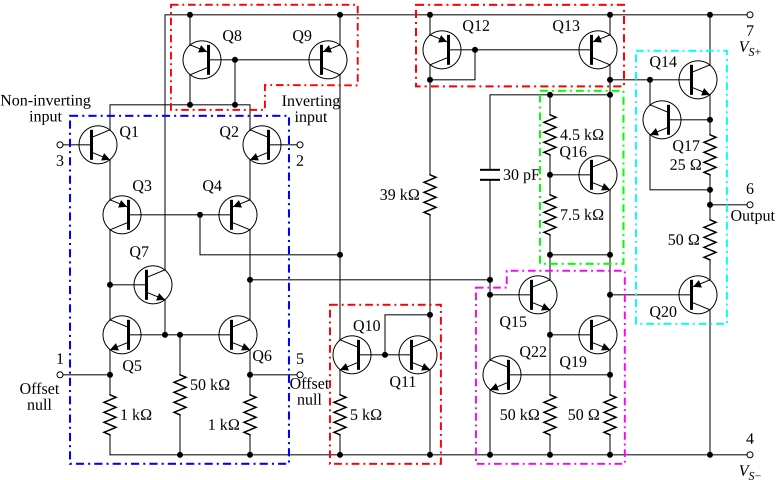This article will not discuss about the mathematical interpretation of OpAmp. Rather, it'll be talking about why we use OpAmp or Why is OpAmp so important? So, if this is the night before your exam, I cannot help you. But, if you are working on your first OpAmp based project, continue reading.
If you connect the output and the input with a wire, it becomes a buffer IC. You can also call it a power amplifier. It means, output voltage will be same as input, but you can amplify the current. Hence drive a power hungry device, such as, a motor.
Figure: Typical OpAmp Symbol
How does OpAmp work?
Truth is, I don't know. All I know is there are at-least 13 transistor inside an OpAmp and together, they do magic. In the past, there has been a lot of research on how to make OpAmp more efficient and useful. So, if we are to understand the exact working procedure of OpAmp, it'll take a lot of study. Even today, I have no clue how an OpAmp function internally, although I've done numerous projects with it. So today, I'm going to talk about OpAmp from application point of view.
OpAmp has 3 basic functions:
- Amplifier
- Comparator
- Buffer
Figure: 'Inverting' Amplifier
If you connect the output and the input of an OpAmp through a resistor, it'll function as an amplifier. Depending on your connection, it can be either an 'inverting amplifier' or an 'non-inverting amplifier'. Whatever it is, it is basically the same. It'll amplify your input signal. I find it easy to use OpAmp as an amplifier. It is less hassle than to design an amplifier using transistor alone.
If the output and input are not connected, then the OpAmp will function as a comparator. It is another very useful application. It allows you to compare an unknown voltage against a know voltage. Using multiple OpAmp and multiple known voltage reference, you can even design a low quality digital multimeter. You can make a line follower Robot using only comparators.
Figure: 'Buffer Ic'
If you connect the output and the input with a wire, it becomes a buffer IC. You can also call it a power amplifier. It means, output voltage will be same as input, but you can amplify the current. Hence drive a power hungry device, such as, a motor.
OpAmp are also used where some sort of electrical isolation is required between two devices. Output pin's voltage and current depends on the biasing voltage of OpAmp. So whatever load is connected to output pin of OpAmp, it draws power from the same source as the OpAmp, not from the device which acts input to the OpAmp.
My insight:
You all know, the age of personal computer began after the invention of transistors. A microprocessor will do anything you program it to do. OpAmp is basically a collection of transistors. Therefore, any program you write on a microprocessor or a micro controller (say operating a robot), same function can be implemented by OpAmp alone. Of course, the circuit will be enormous. But it's possible.
In general, OpAmp decreases the difficulty of putting together multiple elements in a circuit. Same IC can perform a different task only by changing it's external connections.
In any semiconductor book, you'll find OpAmp appears before MOSFET and transistor. Technically, operation of MOSFET and transistors are easier to understand and OpAmp is a complex arrangement of transistors. So why introduce OpAmp first? Well, this is mainly because, in professional world, we are most likely to use OpAmp for amplification / comparison purpose. Other uses of transistors are easy to understand and it's function are limited. Furthermore, OpAmp are much more fun to work with. So don't worry about OpAmp's related equation first. Play with it. Get to know OpAmp. Then you'll have fun time reading about the mathematical explanations.
To know the full working procedure of OpAmp, you can refer to research papers anytime. Or look up on the Internet for some information enrich articles. But be warned, many of those information are result of years of research. So, for obvious reason you might not understand it in one day. But don't give up. Keep reading them. Study EEE hardier. And one day, help me understand OpAmp better!







1 comment:
joss... it ll definitely b helpful to all. :) thank u bro...
Post a Comment